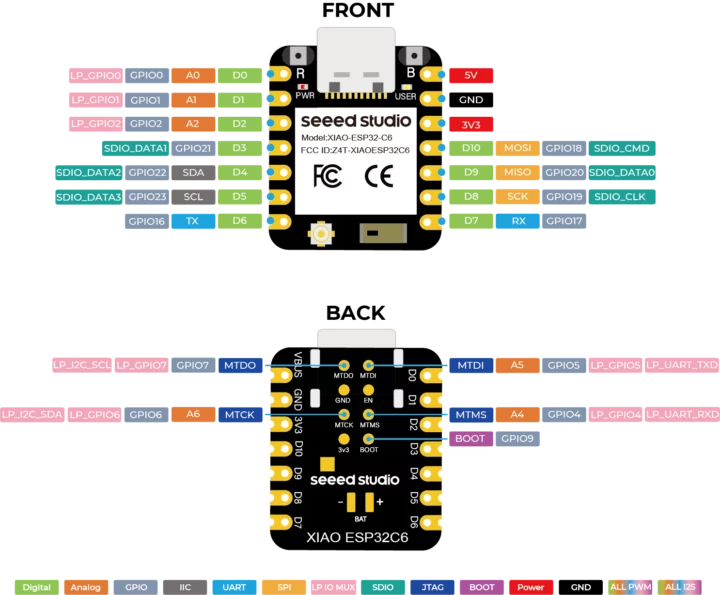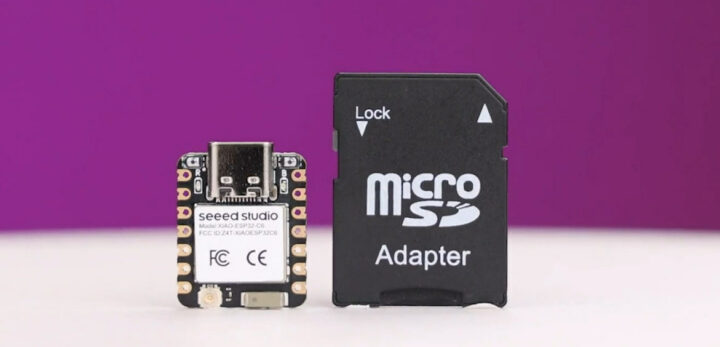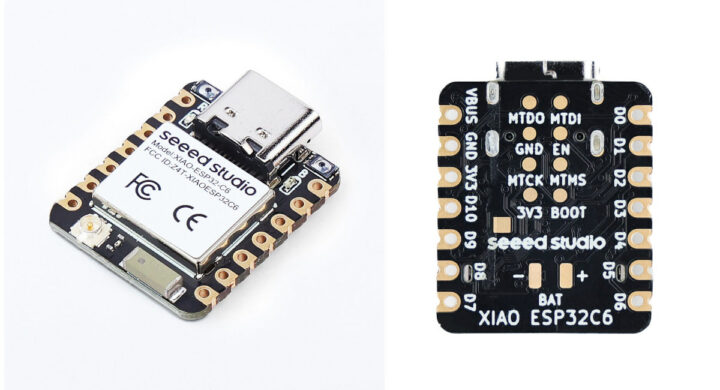Seeed Studio has added yet another member to their XIAO board family with the XIAO ESP32C6 powered by an ESP32-C6 WiFi 6, Bluetooth LE 5, and 802.15.4 (Thread/Zigbee) RISC-V microcontroller and offering up to 16 GPIOs (headers + pads) in a tiny 21 x 17.5 mm form factor that’s smaller than a typical stamp and makes it one of the smallest ESP32-C6 boards around.
The company started the XIAO family with the Seeeduino XIAO (Microchip SAMD21G18) in 2020, and since then they’ve made several other variants with different processors including the XIAO RP2040, XIAO ESP32C3, and XIAO ESP32S3. The XIAO ESP32C6 is the latest (10th) iteration of the board and the first to support WiFi 6, BLE, and 802.15.4 wireless connectivity.
XIAO ESP32C6 specifications:
- Wireless MCU – Espressif Systems ESP32-C6
- CPU
- Single-core 32-bit RISC-V clocked up to 160 MHz
- Low-power RISC-V core @ up to 20 MHz
- Memory – 512KB SRAM, 16KB low power SRAM
- Storage – 320KB ROM, and 4MB flash
- Wireless – 2.4 GHz WiFi 6, Bluetooth 5.0 LE/Mesh, 802.15.4 radio for Zigbee 3.0 and Thread. Matter compatible.
- CPU
- Antenna – External u.FL antenna or ceramic antenna; selectable by software (GPIO 14)
- USB – USB Type-C port for power and programming
- Expansion I/Os
- 2x 7-pin headers (through holes and castellated holes) with 1x UART, 1x I2C, 1x SPI, 11x GPIO (PWM), 3x ADC, SDIO, 5V, 3.3V, and GND
- 8x pads with Low Power UART, Low Power I2C, 5x GPIO, 3x ADC, BOOT, JTAG, EN, 3.3V, and GND
- Misc – Reset button, Boot button, power LED, user LED
- Power Supply
- 5V via USB Type-C port
- Support for 4.2V LiPo batteries with battery charging chip, charging current: 100mA
- Circuit operating voltage – 5V @ 9mA through USB; 3.8V @ 9mA with battery
- Power consumption @ 3.8V
- About 15 μA in deep sleep mode
- About 2.5 mA in light sleep mode
- About 30 mA in modem sleep mode
- Dimensions – 21 x 17.5mm
- Temperature Range – -40°C to 85°C

Seeed Studio says the board is programmable with the ESP-IDF framework or the Arduino IDE. The company provides detailed instructions to get started with the latter, plus some sample code (GPIO, WiFi, Bluetooth), and instructions for AWS IoT integration in the wiki, along with schematics and KiCAD libraries for those who want to integrate the tiny ESP32-C6 board into their custom carrier board.
The XIAO ESP32C6 board can be purchased on Seeed Studio for $5.20 plus shipping. Note this does not include any headers. The company also has a promotion with a 10% discount when buying 3 or more of the same XIAO product (mixed single packs are not eligible) with free shipping and $5 off for new “subscribers”. Finally, the XIAO ESP32C6 is also offered on Aliexpress by another seller which may or may not be cheaper depending on the shipping fee and ordered quantity.


Jean-Luc started CNX Software in 2010 as a part-time endeavor, before quitting his job as a software engineering manager, and starting to write daily news, and reviews full time later in 2011.
Support CNX Software! Donate via cryptocurrencies, become a Patron on Patreon, or purchase goods on Amazon or Aliexpress





